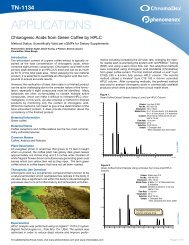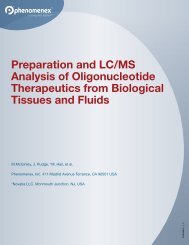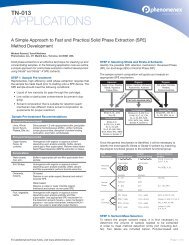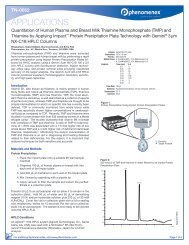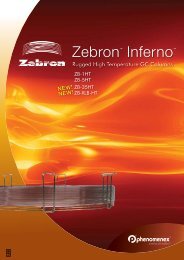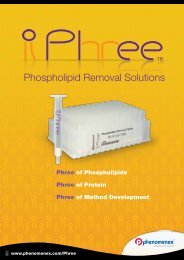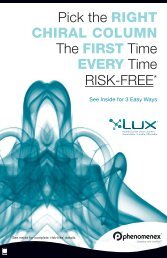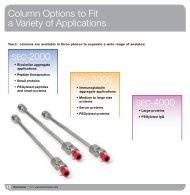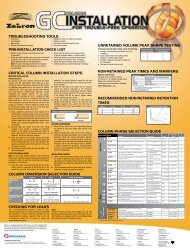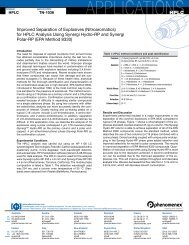Method Development for Chiral LC/MS/MS Analysis ... - Phenomenex
Method Development for Chiral LC/MS/MS Analysis ... - Phenomenex
Method Development for Chiral LC/MS/MS Analysis ... - Phenomenex
You also want an ePaper? Increase the reach of your titles
YUMPU automatically turns print PDFs into web optimized ePapers that Google loves.
<strong>Method</strong> <strong>Development</strong> <strong>for</strong> <strong>Chiral</strong><br />
<strong>LC</strong>/<strong>MS</strong>/<strong>MS</strong> <strong>Analysis</strong> of<br />
Acidic Stereoisomeric<br />
Pharmaceutical Compounds<br />
with Polysaccharide-based<br />
Stationary Phases<br />
Liming Peng, Swapna Jayapalan, and Tivadar Farkas<br />
<strong>Phenomenex</strong>, Inc., 411 Madrid Ave., Torrance, CA 90501 USA<br />
PO87820611_L_1
Introduction<br />
Developing simple and straight<strong>for</strong>ward reversed phase<br />
(RP) chiral <strong>LC</strong> separations coupled with highly sensitive<br />
<strong>MS</strong> detection is required <strong>for</strong> conducting drug metabolism<br />
and pharmacokinetic studies of stereoisomers and<br />
a challenging part of the drug discovery process.<br />
We have presented our successful results on using<br />
polysaccharide-based stationary phases coupled with<br />
API-<strong>MS</strong>/<strong>MS</strong> detection <strong>for</strong> the analysis of various basic<br />
and neutral pharmaceutical compounds in reversed<br />
phase elution using NH4HCO3 or NH4Ac as buffer salts<br />
and acetonitrile or methanol as organic modifiers. 1 This<br />
investigation is extended to the effectiveness of using an<br />
acidic mobile phase <strong>for</strong> the separation and detection of<br />
acidic stereoisomers by ESI or APCI <strong>LC</strong>/<strong>MS</strong>/<strong>MS</strong> and to<br />
method development of <strong>Chiral</strong> <strong>LC</strong>/<strong>MS</strong>/<strong>MS</strong> analysis using<br />
polysaccharide-based chiral stationary phase (CSPs).
Figure 1. Structures of <strong>Chiral</strong> Phases<br />
Lux ® Cellulose-2 or-4<br />
Cellulose tris (3-chloro-4-methylphenylcarbamate) or<br />
(4-chloro-3-methylphenylcarbamate)<br />
Cl<br />
Lux ® Amylose-2<br />
Amylose tris (5-chloro-2-methylphenylcarbamate)<br />
Cl<br />
OCONH<br />
CH 3<br />
O CONH<br />
CH 3<br />
Cl<br />
O<br />
O<br />
Cl<br />
HNOCO OCONH<br />
CH 3<br />
CH 3<br />
Cl<br />
HNOCO<br />
O<br />
CH 3<br />
O<br />
O CONH<br />
Cl<br />
Lux ® Cellulose-1<br />
Cellulose tris (3,5-dimethylphenylcarbamate)<br />
CH 3<br />
CH 3<br />
HNOCO<br />
OCONH<br />
O<br />
O<br />
OCONH<br />
CH 3<br />
CH 3<br />
CH 3<br />
CH 3<br />
Me<br />
Cl<br />
Me<br />
OCONH<br />
Lux ® Cellulose-3<br />
O<br />
Cellulose tris (4-methylbenzoate)<br />
O<br />
CH 3<br />
Cl<br />
MeCH3<br />
O<br />
HNOCO<br />
OCONH<br />
C<br />
Me<br />
O<br />
O<br />
O<br />
C<br />
O<br />
O<br />
O<br />
C<br />
Me<br />
O<br />
Cl<br />
MeCH3
Figure 2. Molecular Structures of Acidic Racemates<br />
OH<br />
O<br />
S<br />
OH<br />
Cl<br />
OH<br />
O<br />
F<br />
N<br />
H<br />
O<br />
O<br />
N<br />
O<br />
O<br />
O<br />
OH<br />
OH<br />
HO<br />
Ibuprofen Flurbiprofen Suprofen Fenoprofen Carprofen Indoprofen<br />
O<br />
O<br />
OH<br />
NH<br />
N<br />
O<br />
HO<br />
O<br />
HO<br />
O<br />
O<br />
OH<br />
O<br />
N<br />
O<br />
O<br />
S<br />
O<br />
N<br />
OH<br />
B<br />
OH<br />
H 3<br />
C<br />
Proglumide<br />
H<br />
N<br />
Etodolac<br />
CH 3<br />
O<br />
O<br />
OH<br />
O<br />
Abscisic Acid<br />
OHOOO<br />
H<br />
N<br />
N<br />
H S<br />
O O<br />
Cl<br />
OH<br />
Mecoprop Ketorolac 1-(Phenylsulfonyl)-3-<br />
indoleboronic acid<br />
Cl H<br />
N Cl<br />
Cl<br />
CF 3<br />
O<br />
N<br />
H S<br />
S<br />
O NH 2<br />
O O<br />
O<br />
S<br />
O NH 2<br />
Warfarin Bendroflumethiaze Trichlormethiazide
Table 1. MRM Transitions and Concentrations<br />
of Acidic Racemates<br />
Compound IS and MRM Conc.* Compounds IS and MRM Conc.*<br />
Ibuprofen ESI - 205.1/160.1 100 Abscisic acid APCI - 263.0/152.7 50<br />
Flurbiprofen ESI - 243.0/198.7 50 Mecoprop ESI - 214.1/141.7 50<br />
Suprofen ESI + 261.1/111.0 50 Ketorolac ESI - 254.0/209.8 50<br />
ESI + 256.2/105.0<br />
Fenoprofen APCI - 241.0/196.8 100 Etodolac ESI - 286.1/242.0 50<br />
Carprofen APCI - 272.8/228.8 100 Warfarin ESI - 307.1/160.9 50<br />
ESI + 309.2/163.1<br />
Indoprofen ESI + 282.1/236.1 50 Bendroflumethiaze ESI - 420.1/77.9 50<br />
Proglumide ESI - 333.1/120.9 50 Trichlormethiazide ESI - 377.8/241.6 50<br />
1-(Phenylsulfonyl)-<br />
3-indoleboronic<br />
acid<br />
ESI - 300.0/209.8 100 * Conc. (ng/mL)
Experimental Conditions<br />
Instrumentation<br />
HP<strong>LC</strong> System: Agilent ® 1200 series<br />
Pump: G1312B (Binary Pump)<br />
Autosampler: G1337C HP-ALS-SL<br />
<strong>MS</strong> Detector: AB SCIEX API 4000 <strong>LC</strong>/<strong>MS</strong>/<strong>MS</strong> -Turbo V Source with ESI or APCI probe<br />
<strong>MS</strong> Detection<br />
TurbolonSpray ® —ESI or APCI in Positive or Negative Ion Mode; MRM transition<br />
HP<strong>LC</strong> Conditions<br />
Flow Rate: 0.2 mL/min (3 µm, 150 x 2.0 mm) or 1.0 mL/min (5 µm, 250 x 4.6 mm), flow split to<br />
0.25 mL/min into <strong>MS</strong>/<strong>MS</strong><br />
Injection Volume: 5 µL (150 x 2.0 mm) or 20 µL (250 x 4.6 mm)<br />
Columns: Lux ® Cellulose-1 3 µm 150 x 2.0 mm<br />
Lux ® Cellulose-2 3 µm 150 x 2.0 mm<br />
Lux ® Amylose-2 3 µm 150 x 2.0 mm<br />
Lux ® Cellulose-4 5 µm 250 x 4.6 mm<br />
Lux ® Cellulose-3 5 µm 250 x 4.6 mm<br />
Kinetex ® 2.6 µm C18 50 x 2.1 mm (used <strong>for</strong> achiral analysis)<br />
Mobile Phases: 1. Acetonitrile/Methanol: 0.1 % Formic acid (FA)<br />
2. Acetonitrile/Methanol: 5 mM NH 4HCO 3 – achiral analysis<br />
3. Acetonitrile/Methanol: 5 mM HCOONH 4 (NH 4FA) – achiral analysis<br />
4. Acetonitrile/Methanol: 5 mM CH 3COONH 4(NH 4AC)- achiral analysis
Figure 3. <strong>LC</strong>/<strong>MS</strong>/<strong>MS</strong> Responses of Acidic<br />
Racemates in ESI - with Different Additives<br />
and Methanol<br />
1500000<br />
0.1 % FA:MeOH<br />
5 mM NH4FA:MeOH<br />
5 mM NH4HCO3:MeOH<br />
5 mM NH4HCO3:MeOH<br />
1250000<br />
1000000<br />
0.1 % FA:MeOH<br />
5 mM NH4FA:MeOH<br />
5 mM NH4HCO3:MeOH<br />
5 mM NH4HCO3:MeOH<br />
750000<br />
500000<br />
250000<br />
0<br />
Warfarin<br />
Etodolac<br />
Ibuprofen<br />
Fenoprofen<br />
Flurbiprofen<br />
Proglumide<br />
Bendroflumethiaze<br />
1-(PS)-3-indoleboronic<br />
Ketorolac<br />
Mecoprop<br />
Carprofen
Figure 4. <strong>LC</strong>/<strong>MS</strong>/<strong>MS</strong> Responses of Acidic<br />
Racemates in ESI- with Different Additives<br />
and Acetonitrile<br />
5 mM NH 4 HCO 3 :CH 3 CN<br />
5 mM NH 4 FA:CH 3 CN<br />
0.1 % FA:CH 3 CN<br />
5 mM NH 4 AC:CH 3 CN<br />
5 mM NH 4 HCO 3 :CH 3 CN<br />
5 mM NH 4 FA:CH 3 CN<br />
0.1 % FA:CH 3 CN<br />
5 mM NH 4 AC:CH 3 CN
Figure 5. The Effect of Acidic Additives on the<br />
Enantioseparation of Acidic Racemates<br />
in RP<br />
Bendroflumethiaze<br />
Lux ® 5 µm Cellulose-1 250 x 4.6 mm<br />
Flurbiprofen (pK a<br />
4.33 )<br />
Lux ® 5 µm Amylose-2 250 x 4.6 mm<br />
mAU<br />
40<br />
DAD1D, Sig=220,8 Ref=off (F:\PHEN4157\HPCHEM\1\DATA\LP0509\LP050507.D)<br />
14.642<br />
VWD1A, Wavelength=220nm(F:\PHEN4228\HPCHEM\1\DATA\LP0310\LP03-22-102010-2\LP03-22-102010-03-2220-12-32\LP-03-<br />
mAU<br />
350<br />
9.047<br />
300<br />
10.061<br />
15.595<br />
min<br />
30<br />
20<br />
10<br />
A. CH 3CN / 0.1 % HAc (40:60)<br />
Rs: 1.64<br />
250<br />
200<br />
150<br />
100<br />
50<br />
D. CH 3CN / 0.1 % HAc (60:40)<br />
Rs: 2.72<br />
0<br />
0<br />
0 2 4 6 8 10 12 14 16 18 min 0 2 4 6 8 10 12 14 min<br />
DAD1D, Sig=220,8 Ref=off (F:\PHEN4157\HPCHEM\1\DATA\LP0509\LP050504.D)<br />
VWD1A, Wavelength=220nm(LP0310\LP03-22-10-22010-03-2310-52-16\LP-03-22-10-015.D)<br />
mAU<br />
mAU<br />
600<br />
4.950<br />
60<br />
14.915<br />
500<br />
5.904<br />
50<br />
B. CH 3CN / 0.1 % FA (40:60)<br />
E. CH<br />
400<br />
3CN / 0.1 % FA (60:40)<br />
40<br />
Rs: 1.65<br />
30<br />
300<br />
Rs: 4.69<br />
20<br />
200<br />
10<br />
100<br />
3.256<br />
0<br />
0<br />
0 2 4 6 8 10 12 14 16 18<br />
0 2 4 6 8 10 12 14 min<br />
DAD1D, Sig=220,8 Ref=off (F:\PHEN4157\HPCHEM\1\DATA\LP0509\LP050511.D)<br />
VWD1A, Wavelength=220nm(LP0310\LP03-22-10-32010-03-2311-47-19\LP-03-22-10-016.D)<br />
mAU<br />
mAU<br />
700<br />
30<br />
4.628<br />
14.954<br />
600<br />
25<br />
15.932 F. CH<br />
500<br />
5.581 3CN / 0.1 % TFA (60:40)<br />
20<br />
15<br />
C. CH 3CN / 0.1 % TFA (40:60)<br />
Rs: 1.64<br />
400<br />
300<br />
Rs: 4.94<br />
15.889<br />
min<br />
10<br />
5<br />
0<br />
0 2 4 6 8 10 12 14 16 18<br />
200<br />
100<br />
0<br />
0 2 4 6 8 10 12 14<br />
min<br />
Conc.: 250 µg/mL; Flow Rate: 1.0 mL/min; Injection: 10 µL; Detection: UV @ 220 nm<br />
HAc ‐ Acetic Acid TFA ‐ Trifluoroacetic Acid
Figure 6. The Effect of Organic Modifier on the<br />
Enantioseparation of Acidic Racemates<br />
in RP<br />
Proglumide<br />
Lux ® 3 µm Cellulose-1 150 x 2.0 mm<br />
Ibuprofen<br />
Lux ® 5 µm Cellulose-3 250 x 4.6 mm<br />
X I C o f -M R M ( 1 2 p a i rs ): 3 3 3 .0 5 2 /1 2 0 .9 0 0 D a fr o m S a m ... M a x . 1 .1 e 5 c p s .<br />
X IC o f - M R M (1 2 p a ir s ) : 2 0 5 .1 4 1 /1 6 0 .9 0 0 D a fr o m S a m ... M a x . 2 .4 e 4 c p s .<br />
1 .1 5 e 5<br />
1 .0 0 e 5<br />
2 . 4 2<br />
CH 3CN / 0.1 % FA (60:40)<br />
2 .0 e 4<br />
CH 3CN / 0.1 % FA (60:40)<br />
8 .0 0 e 4<br />
1 .5 e 4<br />
6 .0 0 e 4<br />
4 .0 0 e 4<br />
1 .0 e 4<br />
2 .0 0 e 4<br />
5 0 0 0 .0<br />
0 .0 0<br />
2 4 6 8 1 0<br />
T im e , m i n<br />
i<br />
X I C o f -M R M ( 1 2 p a i rs ): 3 3 3 .0 5 2 /1 2 0 .9 0 0 D a fr o m S a m ... M a x . 3 .6 e 4 c p s .<br />
2 4 6 8 1 0 1 2 1 4<br />
T im e , m i n<br />
X IC o f - M R M (1 2 p a ir s ) : 2 0 5 .1 4 1 /1 6 0 .9 0 0 D a fr o m S a ... M a x . 6 3 5 9 .0 c p s .<br />
3 .6 e 4<br />
3 .0 e 4<br />
CH 3CN / 0.1 % FA (40:60)<br />
6 0 0 0<br />
5 0 0 0<br />
CH 3CN / 0.1 % FA (50:50)<br />
.9<br />
2 .0 e 4<br />
4 0 0 0<br />
3 0 0 0<br />
1 .0 e 4<br />
2 0 0 0<br />
0 .0<br />
2 4 6 8 1 0<br />
T im e , m i n<br />
i<br />
X I C o f -M R M ( 1 2 p a i rs ): 3 3 3 .0 5 2 /1 2 0 .9 0 0 D a fr o m S a m ... M a x . 1 .6 e 4 c p s .<br />
1 0 0 0<br />
2 4 6 8 1 0 1 2 1 4<br />
T im e , m i n<br />
.1 0 0 a fr o m S a 1 7 1 X IC o f - M R M (1 2 p a ir s ) : 2 0 5 4 1 /1 6 0 .9 D ... M a x . 4 .2 c p s .<br />
1 .5 e 4<br />
7 .2 1<br />
4 0 0 0<br />
CH 3CN / 0.1 % FA (30:70) CH 3CN / 0.1 % FA (40:60)<br />
2 0 .8 4<br />
1 .0 e 4<br />
3 0 0 0<br />
5 0 0 0 .0<br />
2 0 0 0<br />
1 0 0 0<br />
0 .0<br />
2 4 6 8 1 0<br />
T im e , m i n<br />
FA ‐ Formic Acid<br />
2 4 6 8 1 0 1 2 1 4 1 6 1 8 2 0 2 2 2 4<br />
T im e , m i n<br />
s
Figure 7. Enantioseparations on Lux Cellulose-2<br />
with Acetonitrile or Methanol as Modifier<br />
X I C o f -M R M ( 6 p a i rs ): 3 3 3 .0 5 2 /1 2 0 .9 0 0 D a fro m S ... M a x . 2 .3 e 4 c p s .<br />
X IC o f -M R M ( 1 2 p a ir s ): 3 3 3 .0 5 2 /1 2 0 .9 0 0 D a f ro m ... M a x . 1 .4 e 4 c p s .<br />
2 .0 e 4<br />
Proglumide<br />
CH 3CN / 0.1 % FA (40:60)<br />
1 .4 e 4<br />
1 .0 e 4<br />
.2<br />
Proglumide<br />
Methanol / 0.1 % FA (70:30)<br />
0 .0<br />
n<br />
2 4 6 8 t 1 0 1 2<br />
T im e , m i n<br />
e<br />
X I C o f -M R M ( 6 p a i rs ): 2 5 3 .9 4 7 /2 0 9 .8 0 0 D a fro m . .. n M a x . 5 7 8 5 .9 c p s .<br />
2 4 6 8 1 0 1 2 1 4<br />
T im e , m i n<br />
X IC o f -M R M ( 1 2 p a ir s ): 2 5 3 .9 4 7 /2 0 9 .8 0 0 D a f ro m ... M a x . 1 .2 e 4 c p s .<br />
5 7 8 6<br />
4 0 0 0<br />
2 0 0 0<br />
Ketorolac<br />
CH 3CN / 0.1 % FA (40:60)<br />
I<br />
1 .2 4 e 4<br />
1 .0 0 e 4<br />
Ketorolac<br />
Methanol / 0.1 % Formic Acid (70:30)<br />
.<br />
2 4 6 8 1 0 1 2<br />
T im e , m i n<br />
X I C o f -M R M ( 6 p a i rs ): 4 2 0 .0 4 8 /7 7 .9 0 0 D a f ro m S a ...<br />
p<br />
M a x . 1 .3 e 4 c p s .<br />
2 4 6 8 1 0 1 2 1 4<br />
T im e , m i n<br />
X IC o f -M R M ( 1 2 p a ir s ): 4 2 0 .0 4 8 /7 7 .9 0 0 D a f ro m ... M a x. 3 4 0 5 .0 c p s.<br />
1 .0 0 e 4<br />
5 0 0 0 .0 0<br />
Bendroflumethiaze<br />
CH3CN / 0.1 % FA (40:60)<br />
6 .8 4<br />
3 4 0 5<br />
3 .1 4<br />
Bendroflumethiaze<br />
Methanol / 0.1 % FA (70:30)<br />
2 4 6 8 1 0 1 2<br />
T im e , m i n<br />
p<br />
X I C o f -M R M ( 6 p a i rs ): 2 9 9 .9 9 4 /2 0 9 .8 0 0 D a fro m . .. M a x . 1 3 9 6 .8 c p s .<br />
0<br />
2 4 6 8 1 0 1 2 1 4<br />
T im e , m i n<br />
2 9 .8 0 D a f ro m 0 0 X IC o f -M R M ( 1 p a ir s ): 2 9 .9 9 4 /2 0 9 0 ... M a x. 2 2 .1 c p s.<br />
1 3 9 7<br />
1 0 0 0<br />
5 0 0<br />
1-(Phenylsulfonyl)-3-indoleboronic acid<br />
CH 3CN / 0.1 % FA (40:60)<br />
t<br />
.<br />
2 0 0 0<br />
1 5 0 0<br />
.<br />
1-(Phenylsulfonyl)-3-indoleboronic acid<br />
Methanol / 0.1 % FA (70:30)<br />
2 4 6 8 1 0 1 2<br />
T im e , m i n<br />
X I C o f -M R M ( 6 p a i rs ): 2 8 6 .1 0 1 /2 4 2 .0 0 0 D a fro m S ...<br />
p<br />
M a x . 9 .2 e 4 c p s .<br />
2 4 6 8 1 0 1 2 1 4<br />
T im e , m i n<br />
X IC o f -M R M ( 1 2 p a ir s ): 2 8 6 .1 0 1 /2 4 2 .0 0 0 D a f ro m ... M a x . 1 .7 e 5 c p s .<br />
9 .2 e 4<br />
5 .0 e 4<br />
Etodolac<br />
CH 3CN / 0.1 % FA (40:60)<br />
.<br />
.<br />
1 .5 0 e 5<br />
1 .0 0 e 5<br />
Etodolac<br />
Methanol / 0.1 % FA (70:30)<br />
FA ‐ Formic Acid<br />
2 4 6 8 1 0 1 2<br />
T im e , m i n<br />
2 4 6 8 1 0 1 2 1 4<br />
T im e , m i n<br />
,<br />
c<br />
p
Figure 8. Enantioseparations in RP on Lux<br />
Cellulose-1 with Acetonitrile<br />
X I C o f -M R M ( 5 p a i rs ): 2 8 6 .1 0 1 /2 4 2 .0 0 0 D a fro m S a m ... M a x. 3 .0 e 5 c p s .<br />
X IC o f - M R M ( 5 p a i rs ) : 3 3 3 .0 5 2 /1 2 0 .9 0 0 D a fr o m S a m ... M a x . 2 .8 e 4 c p s .<br />
3 .0 e 5<br />
2 .0 e 5<br />
Etodolac<br />
CH 3CN / 0.1 % FA (60:40)<br />
2 .8 e 4<br />
2 .0 e 4<br />
Proglumide<br />
CH 3CN / 0.1 % FA (40:60)<br />
1 .0 e 5<br />
1 .0 e 4<br />
0 .0<br />
2 4 6 8 1 0<br />
T i m e , m in<br />
X I C o f -M R M ( 5 p a i rs ): 3 0 7 .1 3 4 /1 6 0 .9 0 0 D a fro m S a m ... s M a x. 1 .4 e 5 c p s .<br />
0 .0<br />
2 4 6 8 1 0<br />
T im e , m in<br />
X IC o f - M R M ( 2 p a i rs ) : 2 7 2 .7 6 1 /2 2 8 .8 0 0 D a fr o m S a ... M a x . 8 3 6 3 .8 c p s .<br />
1 .4 e 5<br />
1 .0 e 5<br />
Warfarin<br />
CH 3CN / 0.1 % FA (60:40)<br />
8 3 6 4<br />
5 0 0 0<br />
Carprofen APCI -<br />
CH 3CN / 0.1 % FA (60:40)<br />
5 .0 e 4<br />
0 .0<br />
s<br />
2 4 6 1 0<br />
T i m e , m in<br />
X I C o f -M R M ( 2 p a i rs ): 3 7 7 .7 7 4 /2 4 1 .6 0 0 D a fro m S a m ... s M a x. 1 .5 e 5 c p s .<br />
0<br />
2 4 6 8 1 0<br />
T im e , m in<br />
X IC o f - M R M ( 5 p a i rs ) : 4 2 0 .0 4 8 /7 7 .9 0 0 D a fr o m S a m p ... M a x . 1 .1 e 4 c p s .<br />
1 .5 e 5<br />
1 .0 e 5<br />
Trichlormethiazide<br />
CH 3CN / 0.1 % FA (30:70)<br />
1 .0 0 e 4<br />
Bendroflumethiaze<br />
CH 3CN / 0.1 % FA (40:60)<br />
5 .0 e 4<br />
5 0 0 0 .0 0<br />
0 .0<br />
2 4 6 1 0<br />
T i m e , m in<br />
X I C o f -M R M ( 1 2 p a i rs ): 2 9 9 .9 9 4 /2 0 9 .8 0 0 D a fr o m S ... s M a x. 1 0 8 8 .2 cp s .<br />
0 .0 0<br />
2 4 6 8 1 0 1 2<br />
T im e , m in<br />
p a 4 D a fr o m S 4 3 X IC o f - M R M ( 1 2 i rs ) : 2 5 3 .9 7 /2 0 9 . 8 0 0 ... M a x . 9 9 .5 c p s .<br />
1 0 0 0<br />
5 0 0<br />
1-(Phenylsulfonyl)-3-indoleboronic acid<br />
CH 3CN / 0.1 % FA (30:70)<br />
4 0 0 0<br />
3 0 0 0<br />
2 0 0 0<br />
Ketorolac<br />
CH 3CN / 0.1 % FA (30:70)<br />
1 0 0 0<br />
5 1 0 1 5 2 0<br />
5 1 0 1 5 2 0<br />
T i m e , m in<br />
T im e , m in<br />
FA ‐ Formic Acid<br />
c<br />
p<br />
s
Figure 9. Enantioseparations in RP on Lux<br />
Cellulose-4 with Acetonitrile<br />
X I C o f -M R M ( 6 p a i rs ): 2 8 6 .1 0 1 /2 4 2 .0 0 0 D a fro m S a m p l... M a x . 1 .3 e 6 cp s .<br />
X IC o f - M R M (6 p a ir s ) : 3 0 7 .1 3 4 /1 6 0 .9 0 0 D a fr o m S a m p l ... M a x. 1 .8 e 5 c p s.<br />
1 .3 0 e 6<br />
1 .0 0 e 6<br />
Etodolac<br />
CH 3CN / 0.1% FA (50:50)<br />
1<br />
1 .5 e 5<br />
1 .0 e 5<br />
Warfarin<br />
CH 3CN / 0.1 % FA (60:40)<br />
5 .0 0 e 5<br />
5 .0 e 4<br />
t<br />
2 4 6 8 1 0<br />
T im e , m i n<br />
fro m S a m X I C o f -M R M ( 6 p a i rs ): 2 9 9 .9 9 4 /2 0 9 .8 0 0 D a ... M a x . 1 5 7 7 .1 cp s .<br />
0 .0<br />
2 4 6 8 1 0<br />
T im e , m i n<br />
X IC o f - M R M (6 p a ir s ) : 2 5 3 .9 4 7 /2 0 9 .8 0 0 D a fr o m S a m ... M a x. 4 5 5 6 .1 c p s.<br />
1 5 0 0<br />
1 0 0 0<br />
1-(Phenylsulfonyl)-3-indoleboronic acid<br />
CH 3CN / 0.1 % FA (40:60)<br />
.<br />
4 0 0 0<br />
Ketorolac<br />
CH 3CN / 0.1 % FA (40:60)<br />
.<br />
5 0 0<br />
2 0 0 0<br />
t<br />
0<br />
2 4 6 8 1 0 1 2 1 4<br />
T im e , m i n<br />
p a .0 0 fro m S a m s<br />
.7 e X I C o f -M R M ( 6 i rs ): 3 3 3 5 2 /1 2 0 .9 0 D a p l... M a x . 2 4 cp s .<br />
0<br />
2 4 6 8 1 0 1 2 1 4<br />
T im e , m i n<br />
p .7 7 0 fr o m S a m 9 .3 X IC o f - M R M (2 a ir s ) : 3 7 7 4 /2 4 1 .6 0 D a p l ... M a x. e 4 c p s.<br />
2 .7 e 4<br />
2 .0 e 4<br />
Proglumide<br />
CH 3CN / 0.1 % FA (40:60)<br />
8<br />
9 .3 e 4<br />
5 .0 e 4<br />
Trichlormethiazide<br />
CH 3CN / 0.1 % FA (30:70)<br />
.<br />
1 .0 e 4<br />
0 .0<br />
2 4 6 8 1 0<br />
T im e , m i n<br />
X I C o f -M R M ( 6 p a i rs ): 4 2 0 .0 4 8 /7 7 .9 0 0 D a fro m S a m p le ... M a x . 1 .2 e 4 cp s .<br />
0 .0<br />
2 4 6 8 1 0 1 2 1 4<br />
T im e , m i n<br />
p .0 4 D fr o m S a m 1 .5 X IC o f - M R M (6 a ir s ) : 4 2 0 8 /7 7 .9 0 0 a p l e ... M a x. e 4 c p s.<br />
1 .0 0 e 4<br />
Bendroflumethiaze<br />
CH 3CN / 0.1 % FA (50:50)<br />
.<br />
1 .5 e 4<br />
1 .0 e 4<br />
.7<br />
Bendroflumethiaze<br />
CH3CN / 0.1 % FA (80:20)<br />
5 0 0 0 .0 0<br />
5 0 0 0 .0<br />
0 .0 0<br />
2 4 6 8 1 0<br />
0 .0<br />
2 4 6 8 1 0<br />
T im e , m i n<br />
T im e , m i n
Figure 10. Enantioseparations in RP on Lux<br />
Amylose-2 with Acetonitrile<br />
X I C o f -M R M ( 4 p a i rs ): 2 5 3 .9 4 7 /2 0 9 .8 0 0 D a fro m S a m p l... M a x. 2 .4 e 4 cp s .<br />
X IC o f + M R M ( 5 p a i rs ) : 2 5 6 .1 8 9 /1 0 5 .0 0 0 D a fr o m S a m p l ... M a x. 2 .2 e 5 c p s .<br />
2 .0 e 4<br />
1 .5 e 4<br />
Ketorolac<br />
253.95/209.8 (ESI - )<br />
CH 3CN / 0.1 % FA (60:40)<br />
4 .1 9<br />
2 .0 e 5<br />
1 .5 e 5<br />
Ketorolac<br />
256.19/105.00 (ESI + )<br />
CH 3CN / 0.1 % FA (60:40)<br />
4 .1 9<br />
1 .0 e 4<br />
1 .0 e 5<br />
5 0 0 0 .0<br />
5 .0 e 4<br />
1 .0 2 .0 3 .0 4 .0 5 .0 6 .0 7 .0 8 .0<br />
T im e , m i n<br />
X I C o f -M R M ( 4 p a i rs ): 3 0 7 .1 3 4 /1 6 0 .9 0 0 D a fro m S a m p l... M a x. 3 .7 e 4 cp s .<br />
0 .0<br />
1 .0 2 .0 3 .0 4 .0 5 .0 6 .0 7 . 0 8 .0<br />
T im e , m i n<br />
5 p 0 9 .1 .1 0 a fr o m S a m ... M a x. c p s X IC o f + M R M ( a i rs ) : 3 7 8 /1 6 3 0 D p l 7 .0 e 4 .<br />
3 .7 e 4<br />
3 .0 e 4<br />
2 .0 e 4<br />
Warfarin<br />
307.13/160.90 (ESI - )<br />
CH 3CN / 0.1 % FA (60:40)<br />
7 .0 e 4<br />
6 .0 e 4<br />
4 .0 e 4<br />
Warfarin<br />
309.18/163.10 (ESI + )<br />
CH 3CN / 0.1 % FA (60:40)<br />
.<br />
1 .0 e 4<br />
2 .0 e 4<br />
0 .0<br />
n<br />
1 .0 2 .0 3 .0 4 .0 5 .0 6 .0 7 .0 8 .0<br />
T im e , m i n<br />
X I C o f + M R M ( 5 p a ir s ) : 2 6 1 .1 2 0 /1 1 1 .0 0 0 D a f ro m S a m p ... a x. 1 .3 e 5 cp s .<br />
1 .0 2 .0 3 .0 4 .0 5 .0 6 .0 7 . 0 8 .0<br />
T im e , m i n<br />
X IC o f - M R M (4 p a ir s) : 2 4 2 .9 5 4 /1 9 8 .7 0 0 D a fr o m S a m p l ... M a x. 3 .5 e 4 c p s .<br />
1 .2 7 e 5<br />
1 .0 0 e 5<br />
Suprofen<br />
261.12/111.00 (ESI + )<br />
CH 3CN / 0.1 % FA<br />
(60:40)<br />
3 .5 e 4<br />
3 .0 e 4<br />
2 .5 e 4<br />
2 .0 e 4<br />
Flurbiprofen<br />
242.95/198.70 (ESI - )<br />
CH 3CN / 0.1 % FA (60:40)<br />
.<br />
5 .0 0 e 4<br />
1 .5 e 4<br />
1 .0 e 4<br />
0 .0 0<br />
1 .0 2 .0 3 .0 4 .0 5 .0 6 .0 7 .0 8 .0<br />
5 0 0 0 .0<br />
1 .0 2 .0 3 .0 4 .0 5 .0 6 .0 7 .0 8 .0<br />
T im e , m i n<br />
T im e , m i n
Figure 11. Enantioseparations in RP on Lux<br />
Cellulose-3 with Acetonitrile Modifier<br />
X I C o f -M R M ( 9 p a i rs ): 2 1 4 .1 0 2 /1 4 1 .7 0 0 D a fro m S a m ... M a x . 6 .8 e 4 c p s .<br />
X IC o f - M R M ( 9 p a i rs ) : 2 4 0 .9 7 3 /1 9 6 .8 0 0 D a fr o m S a m ... M a x . 1 .6 e 5 c p s .<br />
6 .8 e 4<br />
5 .0 e 4<br />
0 .0<br />
Mecoprop<br />
CH 3CN / 0.1 % FA (40:60)<br />
2 4 6 8 1 0 1 2 1 4 1 6<br />
T i m e , m in<br />
X I C o f + M R M ( 5 p a ir s ) : 2 6 1 .1 2 0 /1 1 1 .0 0 0 D a f ro m S a ... M a x . 1 .1 e 5 c p s .<br />
.<br />
1 .6 e 5<br />
1 .0 e 5<br />
Flurbiprofen<br />
CH 3CN / 0.1 % FA (40:60)<br />
5 1 0 1 5 2 0 2 5<br />
T i m e , m in<br />
X IC o f - M R M ( 9 p a i rs ) : 2 5 3 .9 4 7 /2 0 9 .8 0 0 D a fr o m S a ... M a x . 3 8 0 2 .9 c p s .<br />
.<br />
1 .0 0 e 5<br />
Suprofen (ESI + )<br />
CH 3CN / 0.1 % FA (40:60)<br />
3 8 0 3<br />
Ketorolac<br />
CH 3CN / 0.1 % FA (40:60)<br />
0 .0 0<br />
2 4 6 8 1 0 1 2<br />
T i m e , m in<br />
i rs /2 4 a fro m S a c p X I C o f -M R M ( 9 p a ): 2 8 6 .1 0 1 2 .0 0 0 D m ... M a x . 9 .3 e 5 s .<br />
0<br />
2 4 6 8 1 0 1 2<br />
T im e , m in<br />
a i /2 D a f ro m S c p X IC o f + M R M ( 2 p rs ): 2 8 2 .0 9 4 3 6 .1 0 0 a ... M a x . 5 .9 e 4 s .<br />
9 .3 e 5<br />
5 .0 e 5<br />
Etodolac<br />
CH 3CN / 0.1 % FA (40:60)<br />
5 .0 e 4<br />
Indoprofen<br />
CH 3CN / 0.1 % FA (80:20)<br />
0 .0<br />
2 4 6 8 1 0 1 2<br />
T i m e , m in<br />
a /1 D a fr o m S c p X I C o f -M R M ( 1 2 p i rs ): 2 0 5 .1 4 1 6 0 .9 0 0 a ... M a x . 3 .9 e 4 s .<br />
0 .0<br />
5 1 0 1 5<br />
T im e , m in<br />
.0 D a fr o m S M X IC o f - M R M ( 1 2 p a i rs ) : 3 3 3 5 2 /1 2 0 . 9 0 0 a ... a x . 3 .1 e 4 c p s .<br />
3 .9 e 4<br />
Ibuprofen<br />
CH 3CN / 0.1 % FA (95:5)<br />
3 .1 e 4<br />
Proglumide<br />
CH 3CN / 0.1 % FA (80:20)<br />
0 .0<br />
2 4 6 8 1 0 1 2<br />
T i m e , m in<br />
i rs /9 2 fro m S a m M c p X I C o f -M R M ( 2 p a ): 2 4 0 .9 7 3 .9 0 0 D a ... a x . 6 9 0 5 .7 s .<br />
0 .0<br />
2 4 6 8 1 0<br />
T im e , m in<br />
X IC o f - M R M ( 3 p a i rs ) : 2 6 2 .9 6 8 /1 5 2 .7 0 0 D a fr o m S a m ... M a x . 2 .4 e 4 c p s .<br />
6 9 0 6 .<br />
5 0 0 0<br />
Fenoprofen (APCI - )<br />
CH 3CN / 0.1 % FA (40:60)<br />
2 .0 e 4<br />
Abscisic acid (APCI - )<br />
CH 3CN / 0.1 % FA (60:40)<br />
0<br />
5 1 0 1 5 2 0 2 5<br />
0 .0<br />
2 4 6 8 1 0 1 2 1 4<br />
T im e , m in<br />
T im e , m in<br />
,<br />
c<br />
p<br />
s
Results and Discussion<br />
<strong>Chiral</strong> <strong>LC</strong>/<strong>MS</strong>/<strong>MS</strong> experiments<br />
Five different polysaccharide-based chiral stationary<br />
phases – Lux ® Cellulose-1, Lux Cellulose-2, Lux<br />
Cellulose-3, Lux Cellulose-4, and Lux Amylose-2<br />
(Figure 1) were explored in the reversed phase elution<br />
mode <strong>for</strong> the separation of a variety of acidic compounds<br />
of pharmaceutical interest in mobile phases made of<br />
0.1 % <strong>for</strong>mic acid (FA) with acetonitrile or methanol as<br />
organic modifier and <strong>MS</strong>/<strong>MS</strong> detection.<br />
Selection of mobile phase additives<br />
As acidic analyte presents as anion ion at the neutral pH,<br />
which is not suitable <strong>for</strong> retaining on polysaccharidebased<br />
CSPs and resulting in early elution without<br />
enantiseparation, the acidic additive is often used<br />
as a counter ion in mobile phase <strong>for</strong> suppression of<br />
dissociation of acidic analyte to increase the elution time<br />
and enantioselectivity of acidic racemates on CSPs.<br />
Three acids - trifluoroacetic acid (TFA)- pK a<br />
0.59; <strong>for</strong>mic<br />
acid (FA) - pK a<br />
3.75; acetic acid HAc) - pK a<br />
4.76 were<br />
evaluated on Lux Cellulose-1 and Lux Amylose-2 CSPs as<br />
acidic additives. In general, these additives provide similar<br />
enantioresolution <strong>for</strong> weakly acidic racemates (Figure 5,<br />
a, b, c) while the stronger acidic additive (TFA) per<strong>for</strong>ms<br />
better <strong>for</strong> the stronger acidic racemates (Figure 5, d, e,<br />
f). Formic acid provides comparable enantioseparations<br />
and peak shapes to TFA. Considering the “memory<br />
effect” of TFA on polysaccharide-based CSPs and its<br />
ion suppressing tendency in <strong>MS</strong> detection, <strong>for</strong>mic acid<br />
is preferred over TFA in RP MPs <strong>for</strong> the chiral separation<br />
and <strong>MS</strong>/<strong>MS</strong> detection of acidic racemates.<br />
Effect of mobile phase additives<br />
The <strong>LC</strong>/<strong>MS</strong>/<strong>MS</strong> responses of acidic racemates with ESI in<br />
negative mode in 5 mM HCOONH4, 5 mM CH3COONH4<br />
and 5 mM NH4HCO3 containing mobile phases with<br />
either acetonitrile or methanol as organic modifier using<br />
an achiral column – Kinetex ® C18 – were compared<br />
to responses in 0.1 % FA (Figure 3 and 4). The results<br />
show that <strong>MS</strong>/<strong>MS</strong> responses are comparable in 0.1<br />
% FA CH 3<br />
CN or MeOH to the responses of analytes<br />
in other additives considerd here in the ESI- mode.<br />
This proves that 0.1 % FA as acidic additive in mobile<br />
phases is compatible <strong>for</strong> <strong>MS</strong>/<strong>MS</strong> detection and favored<br />
<strong>for</strong> enantioseparation of acidic racemates, except<br />
<strong>for</strong> carprofen which showed very poor responses<br />
in all of the additives at ESI - mode. This proves that<br />
0.1 % FA as acidic mobile phase additive is fully<br />
compatible with <strong>MS</strong>/<strong>MS</strong> detection of acidic racemates<br />
and can be implemented as the first choice.<br />
Effect of organic modifier on chiral resolution<br />
Acetonitrile or methanol was used in chiral RP HP<strong>LC</strong><br />
separations as organic modifiers. Decreasing the<br />
eluting strength of the mobile phase by decreasing<br />
the portion of acetonitrile or methanol in the mobile<br />
phase will increase retention and resolution (Figure 6).<br />
However, once enantiomers elute later than 10 minutes<br />
with only partial resolution, baseline separation can<br />
rarely be achieved by further decreasing the % organic<br />
modifier in the mobile phase. In our study, acetonitrile<br />
was more successful in providing chiral resolution<br />
on Lux CSP in RP mode compared to methanol<br />
(Figure 7).<br />
<strong>Chiral</strong> <strong>LC</strong>/<strong>MS</strong>/<strong>MS</strong> applications<br />
Figures 8-11 demonstrate 15 chiral separations on<br />
Lux ® CSPs. APCI - source was employed <strong>for</strong> the <strong>MS</strong>/<strong>MS</strong><br />
detection of carprofen, abscisic acid, and fenoprofen as<br />
APCI - provides much better <strong>MS</strong>/<strong>MS</strong> signals than ESI - <strong>for</strong><br />
these three acidic racemates. ESI + mode was used <strong>for</strong><br />
the <strong>MS</strong>/<strong>MS</strong> detection of suprofen. Most compounds<br />
evaluated here eluted in less than 10 min with baseline<br />
resolution in mobile phases of various eluting strength.<br />
The results show that Lux ® Cellulose-3 was most<br />
successful in separating acidic racemates (10 racemates),<br />
especially non-steroidal anti-inflammatory racemates.
Conclusions<br />
Fifteen successful chiral <strong>LC</strong>/<strong>MS</strong>/<strong>MS</strong> analyses are<br />
demonstrated <strong>for</strong> acidic racemic compounds on the<br />
polysaccharide-based CSPs Lux Cellulose-1, Lux<br />
Cellulose-2, Lux Cellulose-3, Lux Cellulose-4, and Lux<br />
Amylose-2 in reversed phase elution mode.<br />
Formic acid as acidic additive in mobile phases is<br />
compatible <strong>for</strong> <strong>MS</strong>/<strong>MS</strong> detection and favored <strong>for</strong><br />
enantioseparation of acidic racemates in RP.<br />
Increasing the volume fraction of organic modifier<br />
(acetonitrile or methanol) in the RP mobile phase<br />
has the expected effect: it decreases retention and<br />
enantioselectivity; adjusting the organic modifier content<br />
of the mobile phase is essential to optimizing chiral<br />
resolution.
References<br />
1. Liming P, Tivadar F, Swapna J, <strong>Chiral</strong>ity 2011 poster<br />
2. H.R. Buser, M.D. Müller, Anal. Chem. 64 (1992) 3168<br />
3. M.L. de la Puente, J. Chromatogr. A 1055 (2004) 55<br />
4. S.M.R. Stanley, W.K. Wee, B.H. Lim, H.C. Foo, J. Chromatogr. B 848<br />
(2007) 292<br />
Trademarks<br />
Lux and Kinetex are registered trademarks of <strong>Phenomenex</strong>, Inc. Agilent is a registered trademark of Agilent Technologies.<br />
API 4000 and Turbo V are trademarks of AB Sciex Pte. Ltd. TurboIonSpray is a registered trademark of AB Sciex Pte. Ltd.<br />
AB SCIEX is being used under license.<br />
Disclaimer<br />
<strong>Phenomenex</strong>, Inc. is not affiliated with Agilent Technologies or AB SCIEX.<br />
Comparative separations may not be representative of all applications.<br />
© 2011 <strong>Phenomenex</strong>, Inc. All rights reserved.



